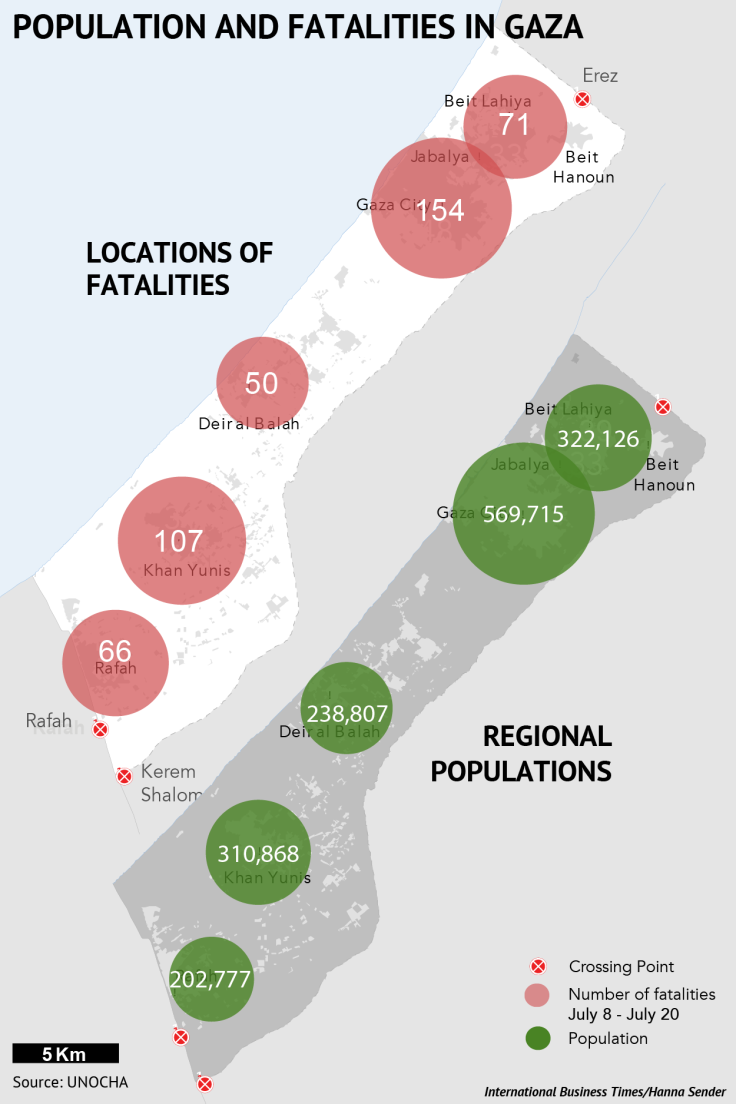118,300 Palestinian Civilians Displaced In Gaza: The Situation in Gaza By The Numbers [INFOGRAPHICS]
The fighting in Gaza between Hamas militants and the Israeli military has displaced more than 50,000 people in the past two days, the greatest number of Palestinians displaced since the conflict began earlier this month.
United Nations Relief and Works Agency for Palestinian Refugees (UNRWA) spokesman Christopher Gunness said as of Tuesday evening in Gaza, there were 118,300 people displaced from their homes, 33,000 more than Monday. A report issued by the organization Monday said UNRWA was providing shelter to 84,843 people in all five areas of the Gaza Strip. The displaced Palestinians have sought refuge in 77 UNRWA shelters.
All available UNRWA schools in #Gaza City & the northern Gaza Strip are now being used as shelters. pic.twitter.com/FtTuSrY9uV
— UNRWA (@UNRWA) July 22, 2014The spike in the number of reported people displaced Tuesday was the second significant increase in just one week. From Sunday to Monday, the number of displaced Palestinians in UNRWA shelters across the Gaza Strip increased by more than 20,000.
According to various reports from Gaza, the UNRWA shelters are reaching their peak capacity. UNRWA is currently hosting about 50,000 people more than it has been able to in the past.
UNRWA issued a statement July 10 saying “the organization can expect to shelter up to 50,000 displaced Gazans in its schools if a ground invasion occurs.”
“The organization holds stock for less than 35,000, a legacy of scarce financial resources that did not allow UNRWA to replenish contingency supplies after the devastating flooding in December 2013,” the statement said.
The border crossings out of Gaza are closed, forcing Gazans to find shelter within the nearly 140-square-mile (362-square-kilometer) strip. There are three crossings currently operating: Rafah, Erez and Kerem Shalom. The Rafah border crossing is open for foreign passport holders and wounded Palestinians, Kerem Shalom for food and fuel, and Erez for foreigners, including journalists, and humanitarian medical cases. Although these border crossings are operating, they are only open at certain times of day, journalists report.

UN reports indicate the 3 kilometer buffer zone, which encompasses roughly 40 per cent of the entire territory, has severely restricted movements within Gaza. The map below shows the estimated coverage of the "No-Go Zone" as well as the larger buffer zone:

CORRECTION July 31, 2014: A previous version of this story contained a photo that misidentified the site of an explosion. The photo has been removed. IBTimes regrets the error.
© Copyright IBTimes 2024. All rights reserved.





















